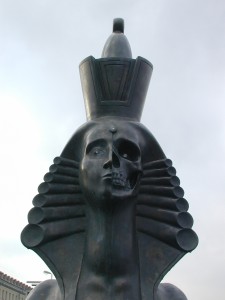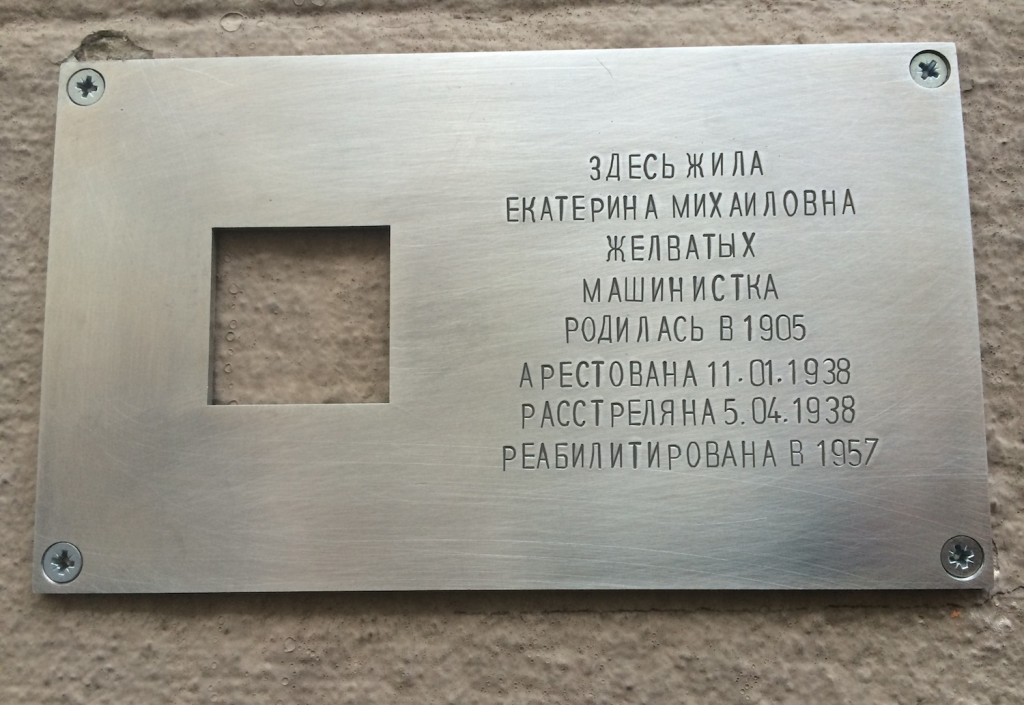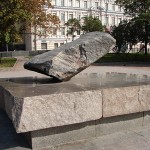
Mikhail Chemiakin’s controversial memorial to the victims of political repression in Petersburg. Author’s photograph
Since the final years of the Soviet Union, memorializing the victims of the political repressions – in itself a curious formulation that indicates some of the problems associated with this subject – has remained a significant and, to a large extent, unresolved question. Historical memory projects can obviously have all sorts of different aims: the educational and the ritual; establishing the narrative of historical events; finding and marking locations associated with those events; gathering or recovering individual and collective memories; and shaping collective identity, to name but a few. It is not surprising, therefore, that these various dimensions have been expressed in many different types of project, from the memory books I listed in my previous post to museums and monuments across the former soviet states.
Alexander Etkind’s article ‘Hard and Soft in Cultural Memory: Political Mourning in Russia and Germany’, Grey Room, No. 16 (2004), 36-59, divides memorialization, as his title suggests, into the ‘hard’ (primarily monuments) and the ‘soft’ (texts). He argues that in Russia the latter has succeeded – with projects such as memory books as well as individual memoirs becoming important sites of memory – whereas the former remains problematic. Although there are multiple monuments to the victims of the Gulag and the terror throughout the former USSR, the absence of a single central memorial points to a lack of unity, and with the failure of earlier attempts to reach agreement on the form or location of a monument, it seems unlikely now that such a thing will ever be built.
As I have been researching memory projects of different types for these posts, a couple of features of the form memorialization has taken have stood out. The first is the rejection of top-down approaches. The absence of consultation is one of the main reasons why Chemiakhin’s memorial in Petersburg pictured above and Neizvestnyi’s ‘Mask of Sorrow’ in Magadan with which I illustrated my previous post have not been universally embraced, to say the least (see Kathleen Smith’s article ‘Conflict over Designing a Monument to Stalin’s Victims’, in J. Cracraft and D. Rowland, eds, Architectures of Russian Identity, Cornell University Press, 2003, pp. 193-203). In a more positive sense, initiatives such as the ‘Last Address’ project I mention below celebrate their collaborative basis through crowd-funding and stress the absence of government support or (so far) interference.
The other aspect that seems important is the way that the temporary has become permanent. The most striking example of this is the Solovetsky stone in Lubyanka Square in Moscow, which was installed by Memorial in 1990 as a temporary monument but, in the absence of agreement about a more permanent (and larger scale) memorial, has come to represent a focal point for memory; it is the location, for example, for the annual ‘Return of the Names’ ceremony detailed below. But this also seems to be what is happening on a wider scale as the supposedly soft products of memory solidify to stand in the place of the missing hard memory. Classic works such as The Gulag Archipelago already have that monumentalizing aim, but this is now magnified by the sheer size of the Sakharov Center’s digital archive of Gulag memoirs, and the access it enables to so many otherwise elusive texts.
In a sense many of the projects I list here are exist on the intersection of soft and hard memory, as their digital presence often transforms one into the other. The online cataloguing of memorials by the Virtual Gulag Museum and the Sakharov Center, and the use of interactive maps by the Last Address project and others, create soft versions of the hard products of memory, while perhaps the most ephemeral form of witnessing – oral testimony – acquires more solidity through its digital form.
My aim here is to create an overview of the different types of memory project relating to the Gulag, including both the primarily digital and those that have some digital dimension. As with my previous post, it has no pretension to completeness; I will update it whenever I have new information, and will be grateful for details of any other projects. In my next post I will discuss the question of contested memory.
Archives, memoirs and virtual museums
Memorial St Petersburg’s Archive is quite well organized with good selection of complete documents.
The most recent version of Memorial’s main website has all sorts of information, but some of the material seems to have got rather lost amidst the reorganization. See the old version of the history page for more usable links to the virtual museum, archives and writing on the repressions.
The Sakharov Center’s archive Vospominaniia o GULAGe [Memoirs of the Gulag] remains one of my most important resources – though how I wish my Zotero button functioned with these, it would make my bibliography compiling so much easier…
I have discussed Gulag: Many days many lives and Virtual’nyi muzei Gulaga [Virtual Museum of the Gulag] in a previous post, so won’t dwell on those now. Other virtual exhibitions worth visiting (and still live) include Tvorchestvo i byt Gulaga on the Memorial website, and the Open Society Archive’s Forced Labor Camps online exhibit.
Vladimir Bukovsky’s Soviet archives are not directly concerned with the Gulag, but contain a significant number of documents about the persecution of dissidents from the 1960s onwards, and the use of psychiatry as a punitive political tool.
Memory and oral history projects
Poslednie svideteli [Last witnesses], developed by Memorial Moscow and Berlin, consists of 26 videos, including individual testimonies and thematic videos covering questions such as women in the camps and transport to Magadan. The testimonies are very moving but at the same time the interviewees are incredibly matter of fact about their experiences.
St Petersburg Memorial’s Gulag: Liudi i sud’by [People and Fates] project has five short videos about the lives of its subjects, including interviews with former prisoners and their children. The videos can also be accessed directly through YouTube.
Sound archives: European memories of the Gulag focuses on citizens from European territories deported to the Gulag from 1939 to 1953 and has some fascinating interviews and other material, organized thematically as well as by individual testimony.
Amnesia Gulag in Europe could have a better title, but this is a solid research and educational project, with a particular focus on visual memory, based at the University of Macerata. The ebook Remembering the Gulag: Images and Imagination, ed. by Natascia Mattucci, has some interesting ideas and articles, but feels a bit like a work in progress.
For oral testimony I would also still recommend Vlast’ Solovetskaia [Solovki Power] as a remarkable piece of film-making with some some extraordinary interviewees, including Dmitry Likhachev – I don’t think it’s been bettered by any other film about the Gulag, documentary or otherwise.
Memorials and memory events
The Virtual Gulag museum’s list of Pamiatniki (587 memorials) and Nekropoli (592 burial grounds) gives copious details for a good many of its entries. I confess I’m slightly mystified by the criteria for inclusion – the Pamiatniki list includes some individual graves, but there are some odd (and obvious) omissions.
The Sakharov Center’s list and map of memorials has 1224 items, but does not include individual graves: Pamiatki zhertvam politicheskikh represii na territorii byvshego SSSR [Memorials to the victims of political repressions in the territory of the former USSR].
Perm Memorial’s list of 101 monuments, memorials and plaques in the Perm region gives an indication of quite how many such memorials there are to victims of the repressions.
Poslednii adres [Last Address], which began in 2014, aims to mark the final addresses where victims of the Soviet repressions lived before their arrest. A crowd-funded project inspired by Gunter Demnig’s Stolpersteine project to commemorate the victims of Nazism, so far 50 of the small metal plaques have been installed on buildings in Moscow and St Petersburg, and a map on the main page of the website shows how many more are currently in preparation. Read more about the Last Address project in the Calvert Journal.
Vozvrashchenie imen [Return of the Names] is an annual event, on 29 October in which people gather around the Solovetski stone in Lubyanka Square in Moscow to read out the names of victims of the repressions. Read Tanya Zaharchenko’s moving account of the ceremony in 2014.

Last address plaque to Ekaterina Mihkailovna Zhelvatykh, Moscow, ul. Mashkova 16. Photograph by Mlarisa CC-BY-SA-4.0
Interactive maps of memory
Topografiia terrora [Topography of Terror] on the Vozvrashchenie imen [Return of the names] website is very good map of area around Lubyanka, where Return of the names ceremony is held every year, showing the number of people from different buildings that died, and with clear outlines of those buildings. It uses data from Moscow Memorial’s Rastreliannye v Moskve [Executed in Moscow] database, and would be very good to see this version expanded.
A larger-scale map of Moscow using the same data can be found at Mapping the Great Terror in Moscow, with links to the Google Fusion Tables used for both this map and an earlier version, Rivers of Blood in Moscow.
Karta pamiati: Nekropol’ terrora i gulaga [Map of memory: Place of burial of terror and the Gulag] is St Petersburg Memorial’s project to map places of executions and secret & mass burials, camp and prison cemeteries, graves of exiles, which has 407 entries at present. It’s well presented, easier to use & more searchable than the original source of much of the information it contains, the Virtual Gulag museum’s list of Nekropoli.
Karta GULAGa [Gulag Map]: special settlements and camps of the Gulag in the Perm region (former Molotov oblast) 1930s-1950s. Related to Perm Memorial’s recently published Memory book, Gody terrora [The Years of Terror].
Mapping the Gulag is an ESRC-funded research project led by Judith Pallot, Laura Piacentini and Dominque Moran as part of a wider project on Russia’s penal geography. See my previous post.
NEW: Topografiia terror [Topogarphy of Terror] by Memorial Moscow, with information on Sharashkas (Gulag research institutes) as well as prisons, and mass execution and burial sites.
NEW: Mapping the Gulag over Time, by Abstractualized. Does what it says on the tin, and more, with links to the data used and an excellent account of the historical questions.
Other historical memory sites
The Sakharov Center’s Programma Pamiat’ o bespravii [Memory of lawlessness] is basically an online part of the museum, and has 4 sections: Mythology and ideology of the Soviet regime; political repressions in the USSR; through the Gulag; opposition to unfreedom in the USSR.
Istoricheskaia pamiat’: XX vek: Gosudarstvennyi terror i politicheskie repressii v SSSR [Historical memory of the 20th Century: State Terror and political repression in the USSR] The State Museum of history of the Gulag and the Sakharov Center are among the partners. The website has sections on repressions, memorial places, resources, discussion, people and their fates, including some memoirs.
There is also a reasonable list of museums devoted to the Gulag and the repressions.
There are some interesting materials on Uroki istorii XX vek [Lessons of 20th century history], which is supported by Moscow Memorial and the German foundation Remembrance, Responsibility and Future (Erinnerung. Verantwortung. Zukunft).
The website Rossiiskie sotsialiisty i anarkhisty posle Oktiabria 1917 goda [Russian socialists and anarchists after October 1917] has a section on Socialists and anarchists in Soviet prisons, labour camps and exile with some interesting resources.


Sunny
/ August 29, 2015Hello! I wonder if you would like to have the contents of your site related to the Gulag and Russias’ tragedy translated into Portuguese. I’d do it for free, at no cost, there are about 300 million people who speak Portuguese, it would be good and morally healthy for them to know – there is not much of it in the Portuguese language, mostly due to indifference (Portugal) or communist censorship (Africa and South America). I have translated http://www.communistcrimes.com, http://www.thegenocideofthesouls.com and http://www.gulag.eu. The reason is that they are launching Shalamovs poems in Brazil in this season where we are undergoing a communist government by a former guerilla. Thank you.
Sarah Young
/ September 15, 2015All the materials on my site have a creative commons licence, as I state here: http://sarahjyoung.com/site/about/. Therefore you can translate whatever you wish, as long as you provide attribution and do not modify it in other ways.